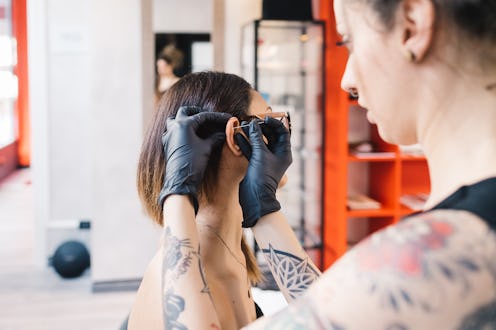Beauty
Everything You Ever Wanted To Know About Caring For A New Piercing
Straight from the pros.

So you've gotten a new piercing. But what do you do afterwards? It is a hole that's punctured through your skin, after all, so there is some healing involved. If you need pointers, Bustle reached out to experts to learn everything you need to know about proper piercing aftercare so that it settles in perfectly.
For the intel, pros such as celebrity piercer Stephanie Anders of Royal Heritage Tattoo, Cassi Lopez-March of So Gold Studios in Brooklyn, New York, and Samantha Alvarado, RN, the head of nurse training at Rowan (a piercing service that offers both in-studio and at-home services) told Bustle their best advice on making sure new body decor spots heal without any issues. And this goes includes best practices for all sorts of piercings, whether you've got one on your ears, nose, belly button, or elsewhere.
Got an aftercare question? Here is your comprehensive guide, which answers everything from what to expect during the healing process, how to clean your piercing, and how to tell if it's infected. Read on for a full rundown of piercing aftercare tips to follow to keep your new body jewel in tip-top shape.
How Long Do Piercings Take To Heal?
The healing time of your new piercing will vary, but the overall average is a couple of months until things appear more normal. According to Alvarado, certain pieces, like a classic lobe piercing done with a gun, can take just six weeks while others may take up to a year to heal. Those that fall into the latter category include cartilage piercings and ones that create larger wounds. The timing is based on a variety of things, including your medical history, she says. "Some medical conditions that require a client to be on immunosuppressant medications will affect any healing process and require additional time and care," she tells Bustle. "Certain heart conditions and diabetes can also affect the healing process due to oxygenation and blood circulation issues."
Despite the long-sounding healing process, Anders notes that you may notice your piercing looking healthier as the months go on. Sometimes, it may not hurt or bother you at all, she says. It just needs time to form epithelial tissue, which is created from cells that grow on the inside of the piercing to prevent foreign bodies from entering.
How Do You Care For A New Piercing As It Heals?
Cleaning your piercing doesn't have to be labor-intensive. "I suggest irrigating the area twice a day, and then drying the area with sterile gauze or, at the very least, a clean paper towel," Lopez-March tells Bustle, noting that this applies to all types of piercings, regardless of location. While she says soap isn't necessary (it can sometimes cause irritation), a "good rinse" with a sterile saline solution or water when you shower "should do the trick." Whatever cleaning solution you use, Alvarado recommends staying away from ointments and anything with alcohol or peroxide, which she says may actually slow down healing.
If you have a piercing in an area that tends to harbor moisture, you'll want to make sure it's kept dry. Lopez-March points to the belly button as one example, since it's often covered and sweat can form. "Piercings heal best when dry, so at the most, using the cold setting on a blow dryer to evaporate that excess moisture can help," she says.
There are certain habits you'll want to avoid, though. First up, avoid using Q-Tips to clean the piercing area. "I don't like to suggest [them] since people tend to be rough with them," says Lopez-March. Also, try not to push on or play with your new piercing (even though it's tempting). "No sleeping on it, no twisting, no touching," she warns. Oftentimes, you may notice some crusty bits around the wound, which Lopez-March says is caused by fluids secreted by the body — be sure not to pick on them as it'll disrupt the natural healing process.
In the current environment, Alvarado says that face mask hygiene is also important with piercing aftercare. "Mask straps are commonly resting behind the ears, which would be the site of a new ear piercing," she tells Bustle. "Mask straps harbor bacteria — if that bacteria enters the site of the new piercing during the healing process, it could create an infection of the piercing site." So be sure you're washing your mask after each use.
What Can You Expect During The Healing Process?
When you get a piercing, it creates what's essentially a puncture wound, says Alvarado. "It's normal for the body to respond with a small amount of edema (swelling), tenderness, and/or redness," she says. "The body will work its magic to heal that wound by producing proteins and then a small amount of scar tissue." She adds that you may see a bit of redness and experience a little swelling and discharge, and Anders says you'll potentially experience itchiness as well (which can make it challenging not to touch the piercing — but don't do it!).
The pros say that piercings of all types and locations have generally the same risk factors and healing processes. That said, Alvarado points to the cartilage as an area that tends to be a bit more sensitive. In this case, just be sure to care for it properly to avoid any disruptions in the healing process.
Just be on the look out for "extensive amounts of swelling, odor coming from the piercing site, or puss," says Alvarado, which are all signs that your piercing may need medical attention. Excessive tenderness may be another thing to watch out for, notes Anders, so if this happens, be sure to contact your piercer for further instruction. Other than that, you're in the clear with your new jewel if you follow proper aftercare practices.
This article was originally published on